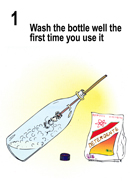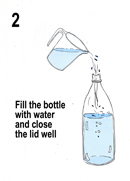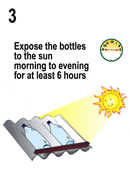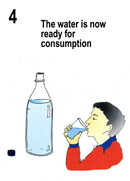How does it work?
 |  |  |  |
Important points to consider when applying the SODIS method
 | Material, colour and shape of the bottleWe recommend using PET bottles in the application of the SODIS method because they are light and do not break. They are also easy to obtain in many regions. However, glass bottles or special bags can also be used. PET bottles are usually labelled as such, but they are not called by the same name in all countries. Factsheet Glass vs. PET (EN, FR, ES) Factsheet Bottle vs. Bag (EN, FR, ES) Factsheet Use of Bags (EN, FR, ES) |
 | TurbidityIf the water is very turbid, the effectiveness of the method is reduced. It is very easy to determine whether the water is sufficiently clear: The filled PET bottle must be placed on top of a newspaper headline. Now one must look at the bottom of the bottle from the neck at the top and through the water. If the letters of the headline are readable, the water can be used. |
 | CloudinessCloudiness affects the strength of solar radiation and thus also the effectiveness of the method. Rule of thumb:
RainThe method does not work satisfactorily during lengthy periods of rain. On these days, we recommend collecting rainwater. |
 | Preventing recontaminationThe treated water should be kept in the bottle and drunk directly from the bottle, or poured into a cup or glass immediately before it is drunk. In this way, it is possible to prevent the treated water from becoming contaminated again. |
